Renegade Legion Leviathan, an Analysis and Suggested Corrections
2023-10-29
Renegade Legion /
RL Leviathan /
Review /
Game Design /
Spaceships /
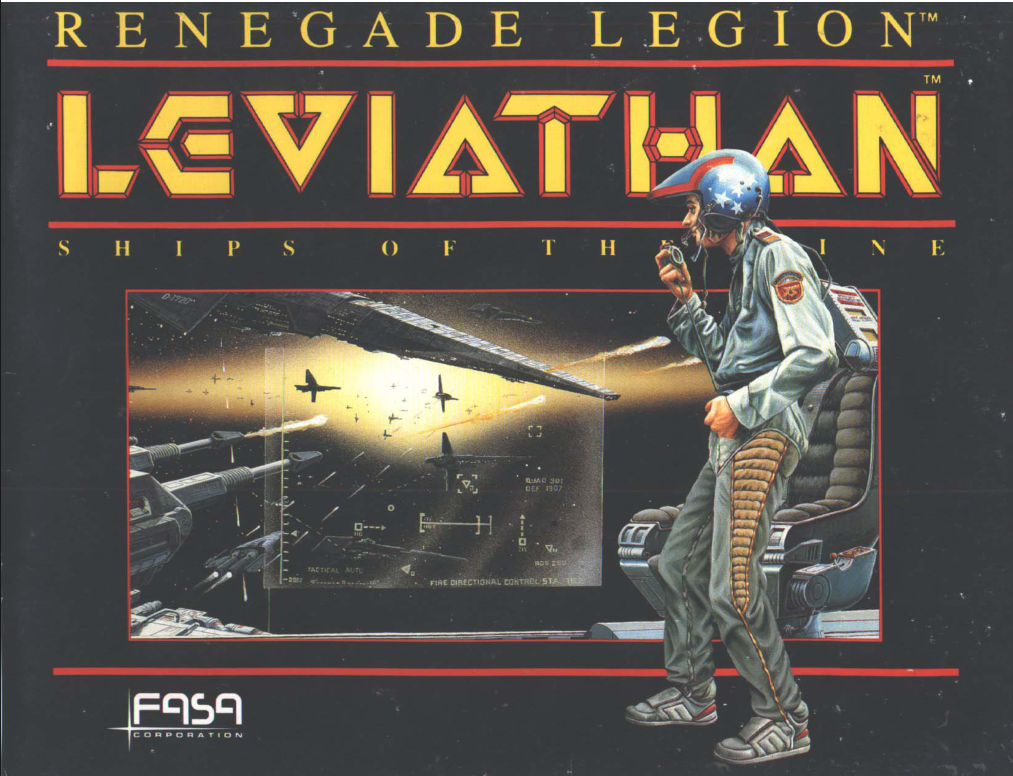
I've been reading capital spaceship games lately, looking for my one true love. Renegade Legion: Leviathan caught my interest in a way nothing else has for a while, despite reading it and playing more than once many years ago. It's got all the elements I want in its type of game.
- Emphasis on Positioning and facing
- Degrading ship states
- Good abstractions
- A sense of ponderous powerful scale
- A sense of verisimilitude
Though it's not without problems. No game is. But it gets enough right in an engaging way that it invites further examination and refinement. What might have been, had it seen as much care and attention for as long as Battletech?
Turn to page 1...
Movement

Large ships, aside from being visually interesting, really distort the scale of the game. And the rules have to bend around them, as seen in the Overlpaping and Collision sections (p11-12) where only aft hexes are considered, the Firing Arcs section (p13-14), and the Target Shield Factor Modifier section (p15). If played at a proper fleet scale, where no ship is larger than a hex (75km), you could chuck most of the fiddlier parts of both. Though considering this is a space game, really collisions at those scales aren't going to happen. But still, it makes big models work, and that's nothing to scoff at. It doesn't bug me as much as I suspect it will bother others.
Target Acquisition
Base to-hit (p15) accounts for range and a 'weight of fire' factor that favors bays over fighters over turrets, and a tracking penalty for fighters that decreases with group size. Damage will apply further modifiers. Bays have a -1 or -2 penalty to hit fighters, which works out to no worse but sometimes better than the turrets to-hit rating which seems like then the turrets have no real advantage to them vs Fighters aside from their flexible arcs. I'm not sure they're working as intended, nor that having a separate to-hit chart is worthwhile instead of just re-using the Fighter targeting penalties.
Weapons Damage
This is the part where things get interesting.
BEHOLD! THE SHIP STATUS SHEET!
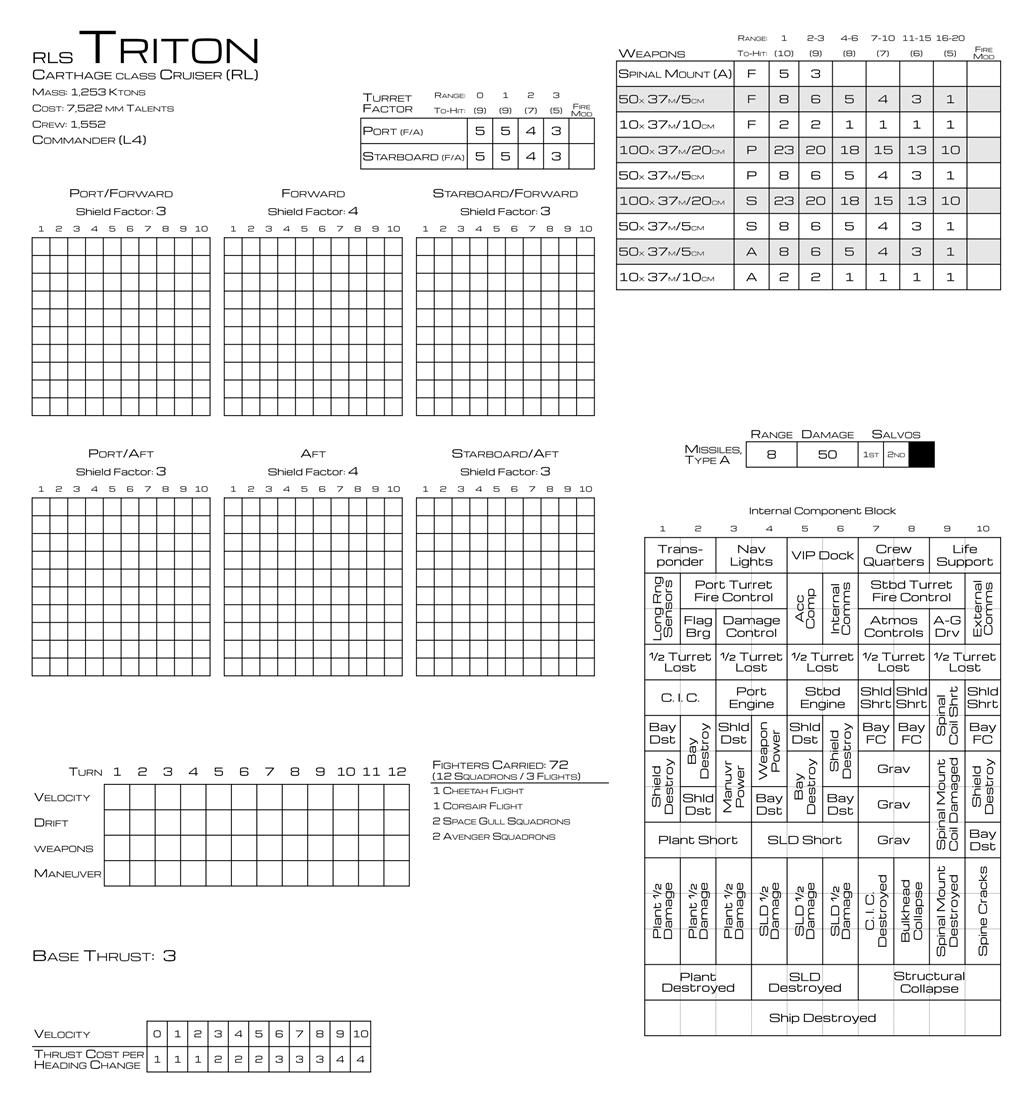
Bays do damage one box per column at a time to the block of their facing.
Spinal weapons ignore shields, can't hit fighters, and do damage in a three-column block to a depth as determined by its class and range to target.

Turrets can only target fighters and missiles, and their fire allocation is the first major "do math on the fly" rule. You can split the damage rating among different targets, but because the damage rating varies with distance, targets at different ranges require you to determine the percentage of fire allocated to each target and then apply that percentage to the damage at their range, rounding down.
An example: Cruiser has enemy fighters at range 1 and 3, allocates 70% of the fire to the range 3 fighters and 30% to the range 1 fighters. The turret damage at range 3 is 3, 70% of 3 is 2.1 rounded down to 2, and the damage at range 1 is 5, 30% of which is 1.5, which rounds down to 1 which is probably not what you wanted to do? This is not a good design, as it's basically an exercise in optimal allocation you have to do every time with a different set of variables.
Proposed fix. One target, proceed as normal. Two targets, -1 to-hit and -1 turret factor to each of the attacks. Three targets, -2 to-hit and -2 turret factor. Four targets, you really don't want to ever do this. It works out to nearly the exact same expected damage output, but is far faster to consider on the fly.
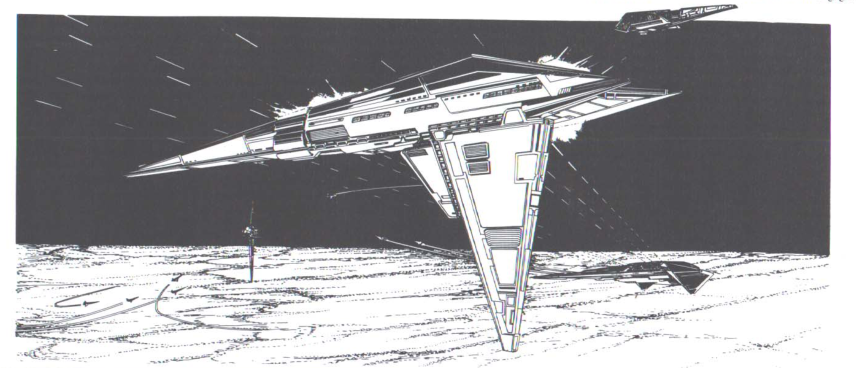
Fighter groups damage as bays, by column. Fighter flights do damage in a narrow column three wide, one box per damage at a time. Squadrons select a column and apply all damage to it. Fighter missiles cannot bypass capital shields, and must wait for a shield to go down. They can be fired at any unshielded target, such as other fighters.
Capital class missile salvos are arc-less, and limited in number. A missile token is produced and moved hex by hex along a path. Any ship with an unfired turret may attempt to shoot down some of the salvo, making a standard turret attack at that range, and destroying 10 times the turret factor of missiles in the salvo. To-hit is 10 minus the target's shield in that arc. Hits bypass shields entirely, misses subtract the shield rating times ten from the missile attack.
And then the ship takes ALL the remaining damage to ALL facings in the target hex. This means a 150 missile attack at a lone fresh destroyer can at best hope to shoot down 30 with turrets, catch 20 on the shields, and then eat 100 in each facing which will obliterate it six times over. 150 vs a lone battleship could turret 60, shield 40, and then take the remaining 50 in 2-3 of its facings which out of a slab of 200 each, isn't much worse than a couple rounds of laser bay fire.
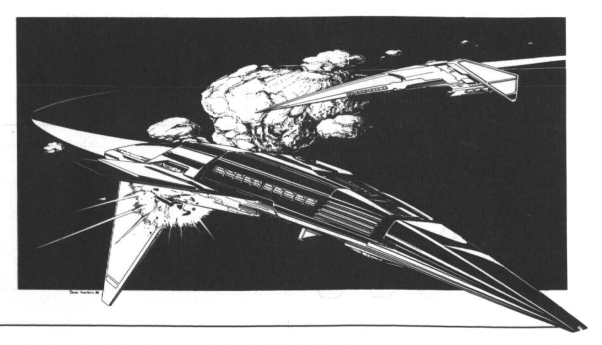
The major problem is dedicated missile boats, smaller ships lobbing big salvos that delete their peers and punch far above their weight. Destroyers can't pack anything heavier than 2 shots of 50 or 1 of 100 which seems right. Destroyers and Frigates both have limits on their Spinal weapons as well. Frigates aren't missile restricted at all though. And sure enough, if you look at the Capital Ship Briefing book, there's the Hermes with it's class E 3 shots of 150. Of the few conversations I can find around the internet about Renegade Legion Leviathan, its name immediately pops up as Exhibit-A of why missiles are broken, and that opinion hasn't shifted for the last 32 years.
>Re: Renegade Legion:Leviathan
>Nov 15, 1991, 5:08:46 PM
>rec.games.board
The big problem I found with Leviathan was the fact that a destroyer with
Hell missiles with smear anything else out of space. Hell missiles will
destroy anything, small ships are cheaper and faster than the big battleships
these two facts combine and result in fleets of small ships armed with
hell missiles that can outfight battleships on a dollar for dollar basis.
Proposed fix. Frigates just need a bay factor restriction on missile systems to keep those out of their reach. 800 or less would limit it to 3x50 or 2x100, putting the 3x100 and 3x150 (which by the way, is also extreme range at 15 hexes) into the Cruiser and Battleship category of weapons.
The other half is the consideration that Destroyers effectively take double the damage of all missile attacks as larger ships will only ever take damage in 3 facings, while the DD has all six in one hex. Limiting the damage to 3 facings feels like a good change maybe? Something to ponder.
System damage once armor is penetrated gets worse and worse as more damage gets through. It starts with purely cosmetic, goes through a few maluses to attack rolls, then to dropped shields and lost guns, then lost power and control, and finally flat out ship death.
By then, the ship is merely a hulk. There are rules for destroying a ship, which cause it to explode in a Death Star scale calamity, which seems like a bolted-on design both because the damage scale is suddenly powers-of-2, but also because the magnitude of the explosion to span more than 75km via the Square-Cube law doesn't pass the sniff test. I think this section is best ignored.
Fighters
Fighters are deployed as either Squadrons (6 Fighters), Flights (4 Squadrons or 24 Fighters) or Groups (3 Flights, or 12 Squadrons, or 72 Fighters). Fighter ranges and stats are compressed compared to capital ships. They have rows of armor boxes that as they are reduced degrade damage output at intervals. Their max attack range is 3, and they have a one-shot anti-fighter missile salvo (at least most of them). Damage spills over from attacked fighters in a hex to any other fighters in the same hex.
OK, here's where things get confusing for me. There's tables of individual fighter stats (why individual? hold on a moment) and then conversions into Leviathan scale squadrons and flights, but not groups. The actual conversion formula are on p26. The Movement and Armor conversions mostly make sense and are straightforward, summing and averaging Interceptor stats.

The attack damage is where it goes off the rails. To find the close range attack value, take the closest range damage of all the non-missile weapons on an Interceptor scale profile, add them together (assumes no misses) and then divide by 20. Ditto their long range attack value, take the medium range damage values from Inteceptor and do the same thing, dividing by 20 again.
Gotta skip ahead to explain something. The very last paragraph and table in the Ship Construction rules is 'Scale Comparisons'.
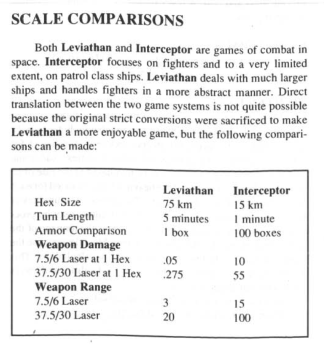
So there's 5 Inteceptor turns for every Leviathan turn, 5 times the distance, 100 times the armor boxes, and 1/200th the damage from weapons. Except, hold on, that's not what's going on back in the Fighter section.
A 7.5m/6cm laser at 1 Hex does .05 Leviathan damage by this chart. And that's sure enough what a bay of 100 does, 5 damage at range 1. But if you look at that same weapon on a Fighter, take the Ictus for instance which has two 7.5/6s and two 7.5/5s (which are a single damage point different), it's listed as having a CRA of 38 (would be 40 if all 4 lasers were 7.5/6s), and a Flight of 24 (approximately 100 7.5/6s) has a CRA of 46. Which means the Fighter is doing 10 times the damage of a bay mount of the same number and specifications of laser which feels immediately wrong.
Maybe the shields substantially reduce the possible fire rate? But then you'd expect to see a similar decrease in damage from incoming fire.
I have a theory.
So the order of Renegade Legion games is Interceptor (fighter combat, 1987), Centurion (grav tank companies, 1988), Leviathan (capital ships, 1989), Legionnaire (the full-on RPG, 1990), and then finally Prefect (operational invasion of a planet, 1992).

Leviathan was designed with a goal of integrating Inteceptor pilots and fighters and even whole squadrons into play. Where you could pause a game of Leviathan and resolve combat between Fighter squads using Interceptor. This procedure is explicitly spelled out in the 1992 Gathering Storm supplement, albeit from Night Shift games under license to FASA.
I think someone plugged the initial numbers for Interceptor into the conversion formula and saw how anemic individual squadrons were and realized there was little chance for glorious Red Squadron trench running the Death Star action, so they cranked up the fighter damage by 10. Which is wild.
So the book has Squadron and Flight stat tables, but don't say anything about Groups beyond acknowledging they exist, including some tokens for them, and alluding to how you would calculate their stats. That's because they're a slap in the face that would give even a casual rules skimmer pause. For context, that Group (72 in count) of Cheetahs, a light recon fighter, have a close attack damage output from their ~200 5m/6cm lasers greater than the 200 37m/20cm + 50 37m/25cm full broadside of a Shiva battleship (58).
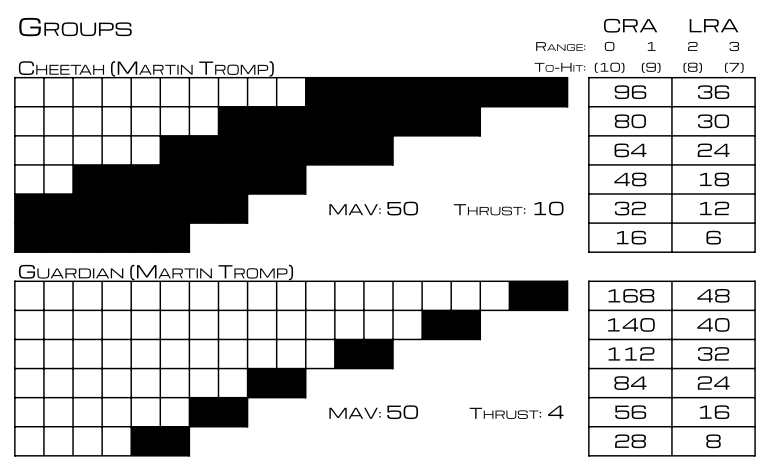
There's a scenario in the back of the book that's just a single fighterless Shiva Battleship vs an entire wing (360) of fighters as organized however the wing commander sees fit. The description is that this should be a close affair, with a 50/50 win/loss ratio. The BB can vaporize a full Group per round with its 3 missiles, and even flights suffer tremendous casualties to bay fire. But if you really do run 60 squadrons, it's almost impossible for the BB to win. ('The Swarm' scenario and fighter dominance is second only to Hermes spam in online discussions)

That's a near guaranteed kill for 1.6 billion credits and 720 crew of fighters (assuming Fluttering Petal fighters) vs a Shiva battleship at a cost of 26 billion credits and 2,700 crew. You'd expect a vastly different space doctrine with ratios like that, more akin to WWII OtH style carrier fleets than WWI dreadnought fights. Hell, a County class Frigate-weight carrier is packing a full wing of 360, so if you factor in the support platform, that's still only another 3.5 billion credits. You could field 5 of those carriers and annihilate entire Battleship squadrons from a safe distance for the price of one Shiva.
Two possible reasons for why carriers aren't that dominant would be micro-FTL jumps that allow a BB to close faster than a carrier can launch fighters, but that kind of movement isn't listed and the optional rules on FTL travel on p30 contradict its viability, but also the way ship construction allocates fighter support bays there's no actual restriction on launch rate so a carrier can dump that entire wing in one turn.
But really, I think it's just that they wanted Interceptor players to be more meaningful to the game.
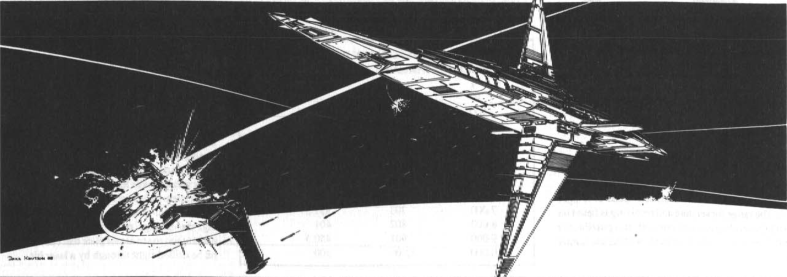
One last thing on Fighters. Missile Attack Values. They get a one-shot (no rules on reloading) anti-fighter or unshielded-target attack. Range 0-3 hexes with no fall off in damage, and is resolved as a normal bay fire / fighter CRA attack (no interception of the missile swarm) and unlike the close and long range damage, does not decrease with damage to the unit. A single box of a Gladius flight hits for 75 if it holds fire and survives.
This section again has some discrepancies. There's a table of conversion between number of interceptor missiles carrier and Leviathan attack value. But that chart does not match the pre-calculated tables at all. Every pre-calc table has the missile attack value shifted one level down. The example below the table even demonstrates how the listed values are wrong when it calculates the example flight and gets an attack that exceeds any pre-calc'd flight by a whole tier. And it's on the same page!
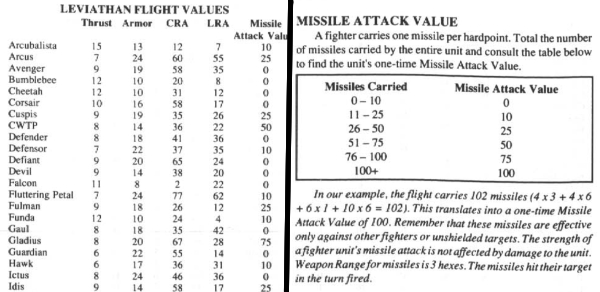
With a max armor of 24 and many Flight missile attacks of 25+, there's a high chance you get to instantly annihilate a peer target. Of course, this is true of both CRA and LRA values as well for fighters, so it's not just a missile problem.
Possible reasons to leave laser and missile fighter damage this high are that since damage is resolved simultaneously, it removes counters from the board. But if that's the design intent, it would be cleaner to abstract further and cut out all the one-box-left matchups.
Proposed fix. So I redid all the calculations, aligned damage output between bays and fighters, but I can't tell if it works or not. Squadrons take advantage of holes in armor or damaged ships, sniping specific columns, but the heaviest hitter among them is the Gladius, able to pinhole a whopping 6 damage. Flights are doing more real work thanks to bigger numbers and inbuilt penetration, with a damage output on-par with a bay full of a hundred light lasers, and able to attack a turned or rolled side. They also mostly can't one-shot peers, except via missile launch.

PDF with full recalculated fighter stats in the Downloads section
Why no Arcubalista? Because I hate it. Stupid outlier ship that goes too fast.
Patrol Class Ships
These are corvettes, gunboats, escorts, anything smaller than a destroyer but bigger than a heavy fighter. Liminal units, not as abstracted as fighters, with extremely pared down capital features. The conversions used on the Interceptor Cingulum and Pegasus as examples are an arbitrary mix of Leviathan and Interceptor rates that have them wildly more durable but only really threatening to squadrons.
Gut sense is make them a Fighter line-item, and field them in groups so they compare to fighters. 2 Cingulum are Thrust 9, ARM 6, CRA 2, LRA 2, MAV 1 which are the exact stats of a squadron of recalculated Martiobarbuluses.
But also, I think they only come up in one Wake of the Kraken scenario and I'd rather ignore yet more non-capital ships.
Optional Rules
Run through these real quick.
- Variable shields is more book keeping but I don't think it would make for a significantly more interesting game. Not a bad idea per se.
- Fighter casualties and pilot survival are there for campaign play where you have named fighters. Would be cooler if fighter repair also depended on count of intact fighter bays on the parent ship.
- Damage Control would be interesting during pickup games, but I'd rather use the rates listed in the system damage section.
- Commander skill is cool (all ships should have names, and their commanders should be named as well), use this one whenever you can.
- FTL travel is mostly an offboard thing or for ships trying to escape in a scenario. No notes.
- Orbital Installations have some system categories I'd like to see on the capital ships. Forget Transponder and Nav Lights, give me lifeboats and Fighter Bays.
- I'm skipping the ground/Centurion section, not in the scope of 'space game' for me now.
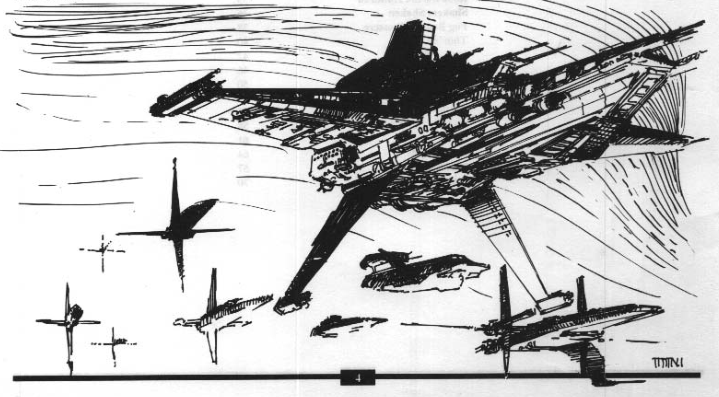
Ship Construction
There's some weirdness in mass where a destroyer is 30% spinal weapon by mass but only 1% engines/power plant, while a battleship is 9% and 33% respectively. That seems off, but it doesn't really matter. Meanwhile, whose to say what things should cost? It's basically points for the game, but also feels arbitrary at times, the precision of cost shifting from 1,000 credits in bays to 10 million credits for missiles and spinal mounts.
The game presents options for underpowering or inefficiently powering vessels, but really you want to just figure out the triple linkage rates and ignore everything else. Which is exactly what I did when I was putting together a spreadsheet ship builder, and is exactly what the designers did for every ship in the Capital Ship Briefing book. Armor you always just use the max unless you're trying to build a sub-standard vessel.
Weapon selection, as I said earlier, missiles need class restrictions on the heavier types and carriers exacerbate the fighter problem.
Ship Sheets
The game has a stapled set of generic ship sheets for you to photocopy. I replicated them with a better arrangement.
Future plans are to make some adjustments to the damage tables, but that's another project. I want to change one thing at a time.
PDF of recreated ship sheets and more in the Downloads section
Final Thoughts
It's important to judge a game not on how you think it should be played, but on how it is designed to be played. And one of the best ways to tell if the designers don't outright print it is by the supplemental material published for a game. For Leviathan, that'd be the campaign book Wake of the Kraken published the same year as the core game, and the only other scenario book 2 years later, Distant Fire, another campaign book.
This is critical to understanding Leviathan, because unlike the overwhelming majority of games, it's designed for campaign play first and foremost. The seemingly overpowered nature of missiles and fighters needs to be examined as expendable assets. Yes, they may end a scenario in a total victory, but if you use them all to do so, what's your plan for the next 4 engagements? Fights should not be even. Forces should not be symmetrical. It's a far better game played as intended than as people might wish it were.
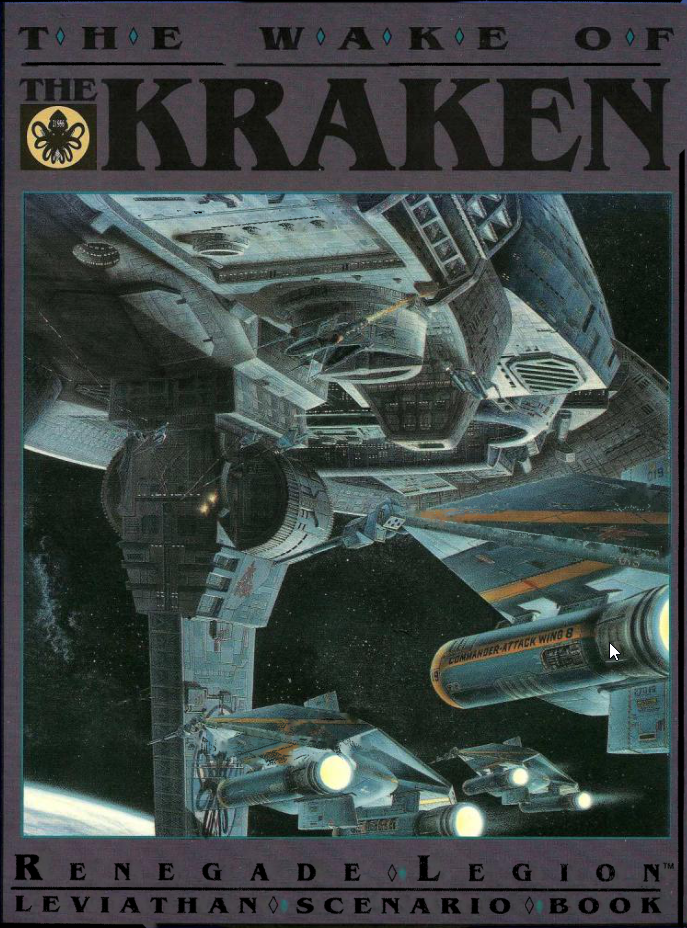 A disgraced (framed?) war hero of an admiral is given a task force of the damned, command of a cursed flagship, and sent off to the front to die gallantly in battle no matter what it takes."
A disgraced (framed?) war hero of an admiral is given a task force of the damned, command of a cursed flagship, and sent off to the front to die gallantly in battle no matter what it takes."
I want to run the Wake of the Kraken campaign with some friends. That's what this is all in service of. We'll be proxying models until I can track down wherever the STLs I saw once upon a time vanished to and I can print up a full Kraken battlefleet. Depending on how long scenarios take, I want us to rotate and each run the Kraken squad, each a different timelines and see who can make it the furthest.